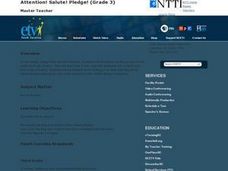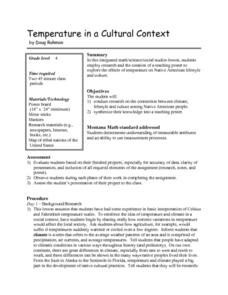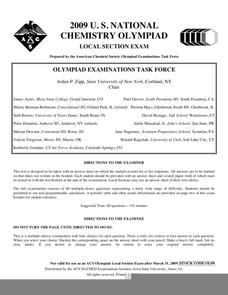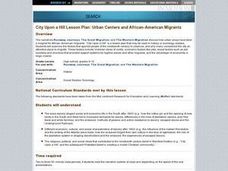Curated OER
Attention! Salute! Pledge!
Third graders recognize the American flag as a symbol. In this symbols lesson, 3rd graders review the video "U.S. Flag: Proper Use" and identify what the stars and stripes represent. Students view an online clip of how to fold the...
Curated OER
Searching the Net
Students create a Native American Nation flip book. In this Native American lesson, students choose one of four Native American Nations: The Iroquois, Hopi, Seminoles, Sioux. They research them on the Internet using teacher given...
Curated OER
A Hoosier Perspective on the March to the Sea: The Diary of William Miller
Eighth graders take a closer look at Sherman's March to the Sea. In this American Civil War lesson, 8th graders analyze the diary entries of William Miller. Discussion questions are included with the entries. Students create illustrated...
Curated OER
“Will I or Won’t I?” Colonel Robert Gould Shaw, 54th Massachusetts Regiment
Students discover the story of the 54th Massachusetts Regiment. In this American Civil War lesson, students study the life of Robert Gould Shaw and the regiment he led. Students research primary and secondary sources to learn about the...
Curated OER
Flags Of Latin America
Middle schoolers determine the symbolism of Latin American flags. For this Latin America lesson, students research the cultures and histories of countries as well as the history behind their flags. Middle schoolers recreate the flags and...
Curated OER
Romare Bearden's The Dove - A Meeting of Vision and Sound
Students explore African american culture of the late 1950's and 60's through various primary sources including literature, music, art and others. They then prepare and conduct a mock interview and present with the class.
Curated OER
Temperature in a Cultural Context
Fourth graders investigate the effects of temperature on Native American lifestyle and culture. In small groups they conduct research on cultural practices showing a connection to the climate and create a poster displaying their...
Curated OER
Civil War Battles: The Reporter's Perspective A WebQuest
Young scholars interpret historical evidence presented in primary and secondary resources. In this research skills instructional activity, students research the job of reporting for new agencies during the American Civil War as they...
Curated OER
Hispanic Arts: Visual Arts, Dance and Music
Students observe global cultures by listening to music and watching videos. In this Latin American dance instructional activity, students define merengue, salsa and other dances from the Hispanic culture while listening to Latin rhythm...
Curated OER
Writing Exercise: Mesoamerica
Use writing to examine Mesoamerica with this short-answer exercise. Informational text isn't provided to help scholars answer these three questions, so you could either provide it or make it an individual research project. Learners...
Curated OER
South America
In this map of South America learning exercise, students study the map of South America and then write the names of the 15 countries and territories on the provided lines.
Curated OER
Take a Memo - Primary Documents: African American Soldiers on the Homefront
Pupils examine the discrimination experienced by black servicemen during World War II. They read and analyze an official memo written in 1943, complete worksheet questions, and participate in a class discussion.
Yale University
The Harlem Renaissance: Black American Traditions
Aaron Douglas, Meta Warrick Fuller, Palmer Hayden, William Johnson, and James Lesesne Wells, the painters and sculptors of the Harlem Renaissance, are featured in a unit study of artists of the Harlem Renaissance.
Curated OER
Who Led the South?
Eighth graders explore the role of Jefferson Davis and his leadership of the Confederacy during the Civil War. They examine the command system used in the Confederacy and analyze the effectiveness of the command system.
Curated OER
The African Slave Trade: From West Africa to South Carolina and Beyond
Eighth graders explore the African slave trade. They identify the principal figures practicing the African slave trades at three locations. Students draw the physical routes of the slave trade on a map and they list the reasons for the...
Curated OER
2009 U. S. National Chemistry Olympiad - Local Section Exam
Here is a copy of a past national challenge exam that you can use in your general chemistry course as a unit or semester review. Sixty multiple-choice questions query learners on properties of matter, stoichiometry, reactions, and...
Curated OER
Investigating the Harlem Renaissance
The work of Langston Hughes opens the door to research into the origin and legacy of the Harlem Renaissance and how the literature of the period can be viewed as a commentary on race relations in America. In addition, groups are assigned...
Curated OER
Vietnam 1945 - 1975 :The 10,000 Day War
Each phase of the Vietnam War is fully developed and defined in terms of political cause and effect and social action. Phase one covers the onset of the war in 1945 through the French defeat at Dienbienphu. Phase two discusses American...
Curated OER
Itaipu Dam and Power Plant (Brazil and Paraguay)
Learners study South America's Itaipu Dam and Power Plant in order to gain an understanding that hydroelectric power is a major means of generating electricity throughout the world. They also look into the environmental impacts that...
Curated OER
Big Business & Industrial Cities
This is a true gem. This PowerPoint is well-organized, has bullet points you control (which gives you time for discussion), has sound effects, and covers several aspects of American industrialization after 1900. The presentation begins...
Curated OER
Transportation and African-American Migration
Students explore the means of transportation available in the 19th century and its role as both facilitator and enabler of the westward expansion. They create a project board illustrating their findings.
Curated OER
Runaway Slaves, An American Experience
Sixth graders explore, analyze and study how one's personal experiences impact one's perspective and actions. They interpret ideas and events of slavery from the different perspectives of an abolitionist, slave owner, United States...
Stanford University
Civil Rights or Human Rights?
Young citizens consider the American civil rights movement as part of the global struggle for human rights. After using a timeline activity to learn about the major events in the civil rights movement, class members study Malcolm X's...
Curated OER
City Upon a Hill: Urban Centers and African-American Migrants
Students examine why fugitive slaves migrated to cities and towns rather than rural areas. In this lesson, students consider the social, economic, and political benefits provided by cities and towns in comparison to rural areas.

























